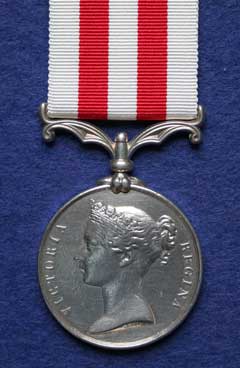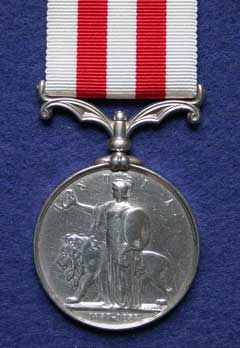MEDAL INFORMATION
Indian Mutiny Medal
(1857 to
1858)
Face
The diademed head of Queen Victoria with the legend “VICTORIA REGINA”.
Reverse
The
standing, helmeted figure of Britannia holding a wreath in her
outstretched right hand, over her left arm the Union Shield. Behind her
is a lion and above her the word 'INDIA'. At the bottom of the medal are
the dates '1857-1858'.
Size &
Composition
Approx. 36 mm in diameter. Medal and bars in silver.
Ribbon
Approx. 32 mm wide. White, red, white, red, white stripes of equal width.
Suspension
Ornamental and faintly horn-shaped and fixed to the disc by a claw and
swivel of a longer type that is usually four on British medals.
Naming
The
Recipient’s initials and surname and his regiment or ship indented on the
edge in Roman Capitals.
Bars
Five were awarded, slightly fish-tailed in shape and incorporating a
rosette at each of the two bottom corners:-
'DELHI' (30 May - 14 September 1857) awarded to the troops engaged in the
re-capturing of the city.
'DEFENCE OF LUCKNOW' (29 June - 22 November 1857) awarded to the original
defenders and the first relief force.
'RELIEF OF LUCKNOW' (November 1857) awarded to those engaged in the relief
of the city.
'LUCKNOW'
(November 1857 - March 1858) awarded to those engaged in the re-capturing
of the city.
'CENTRAL INDIA' (January - June 1858) awarded to those present at certain
other operations in various parts of Central India.
Awarded
Authorised for award to all who were engaged against the mutineers by
General Order No. 363 of 18th August 1858, but General Order No. 771 of
1868 (ten years later) extended the award to all who had been under fire
or who had borne arms. The maximum number of bars awarded to any
individual was four, but many medals were awarded without bars.
The Mutiny
was an attempt to overthrow the authority of the East India Company in
'British' India, which to a degree succeeded, as in August 1858 the
Company's authority was transferred to the Crown. The Mutiny arose out of
a long period of unrest in
India
which came to a head when the provinces of Oudh and the Punjab were
annexed in 1856. Sepoys at Barrackpore mutinied in March 1857 because of
rumours of Christianisation, and the use of cow or pig fat to grease
cartridges, the ends of which had to be bitten off prior to use. But
these were merely touch-stones to spark the fierce underlying feelings of
the native population, both Hindu and Muslim.
On
10th May 1857 at Meerut the first British soldier to be killed in the
Mutiny was Colonel Finnis of the 11th Bengal Native Infantry, and his
death was followed by those of all other Europeans in that city. The
mutineers descended on Delhi and there they proclaimed the Great Mogul
Emperor of India. Lucknow and Cawnpore were among the many cities and
towns in which the European populations were besieged, and the final
suppression of the Mutiny was only achieved in April 1859 after long and
arduous campaigning by many thousands of British and loyal Indian troops.
The King’s
Own
The
Right Wing of the 1st Battalion was sent from Mauritius to India in
September 1857 and did not serve in Central India where the Mutineers were
most active. Companies were engaged with the Mutineers in the attack on
the fort on the island of Beyt off the Gujerat coast on 2nd April 1858
when 23 casualties were suffered, and in the attack and capture of the
village of Maudhata in the Mahi Kauta district in August 1858 where they
suffered no casualties. The 208 officers and men of the Battalion who
were present at either or both of these actions were awarded the Mutiny
Medal without bar. One further medal was awarded as a result of the
changed qualifications for the medal under the General Order No. 771 of
1868, the recipient, Private William Miller, having been engaged on Field
Service under Captain Thomas Sheppard in 1858-59 in pursuit of rebel
forces under Tantia Tope and Rao Sahib. This seems to indicate that
others of the Battalion could possibly have been similarly entitled to the
medal but were, for one reason or another, unaware of the new General
Order.





